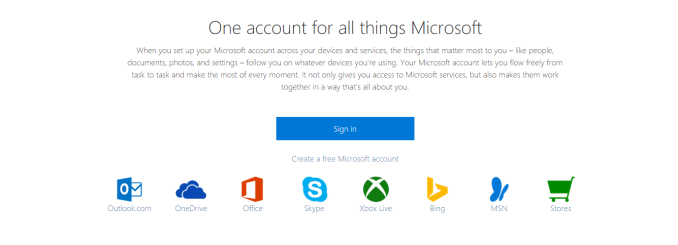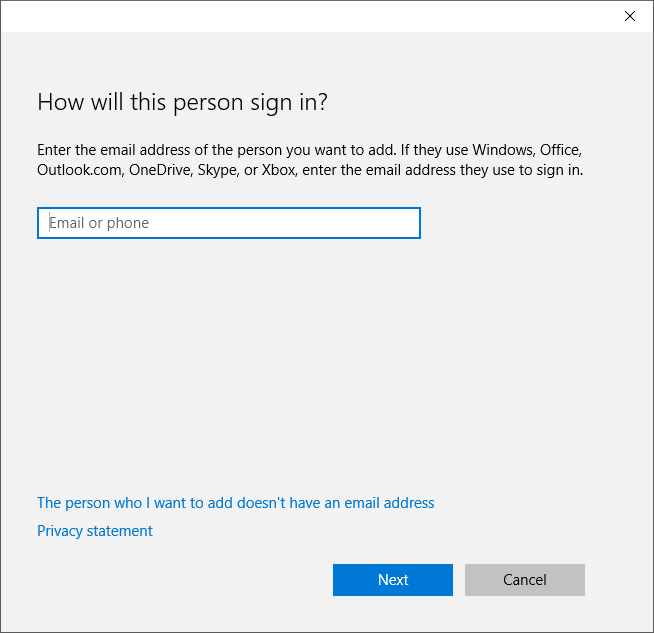The Windows 10 Review: The Old & New Face of Windows
by Brett Howse on August 25, 2015 8:00 AM EST- Posted in
- Operating Systems
- Microsoft
- Windows 10
Why Do I Need a Microsoft Account?
In all versions of Windows up to and including Windows 7, you would create a local account on the computer with a username and password, and log in. Business customers could also have an Active Directory domain, which would allow workers to log in with one set of credentials on any approved domain joined workstation.
Windows 8 introduced the construct of logging into Windows with a Microsoft Account. Logging in with your online profile for Microsoft would then also log you into all of the online services, such as OneDrive for cloud storage, Skype for messaging, and email through outlook.com or Hotmail. Other services, such as weather, could sync your favorites across devices. It also allowed you to optionally sync your computer layout across devices, so your desktop wallpaper, theme, and even your Start Screen layout could all by synchronized across any Windows device you logged into. Also, any password changes would be synchronized as well.
There is certainly people who do not want this though, and Windows 8 made it very difficult to use the Microsoft services if you were not logged in with a Microsoft Account (MSA). During initial setup, the default prompt is to set up the computer with a MSA and although you could bypass this step and create a local account, it was somewhat non-obvious.
For Windows 10, Microsoft has backed off on this somewhat. During setup, the local account option is still not the default, but it is more obvious that you can bypass the MSA login. Most of the built in apps also support login individually rather than at the system level, which gives you the option to log into those services individually if you want to use them, or you can use multiple accounts for things like Xbox in case you have a different profile for that.
Adding a user defaults to MSA but you can choose the link at the bottom to switch to Local Accounts
I think they have found a much better balance with Windows 10 in this regard. Local accounts can now be used without really forcing you to use a MSA for everything. You will lose some features, such as Cortana, if you don’t use a MSA, so it’s not 100% the same but for the people who don’t want to log in with a MSA this is maybe just the way they want it.
So do you need a MSA to use Windows 10? If you want the best and easiest experience, then yes you should use a MSA for Windows 10. You will get the features that we have come to expect from modern systems such as the ability to sync passwords, themes, and more. Hopefully Microsoft will bring back the ability to sync the Start Menu layout like it had in Windows 8 as well, at least as an optional toggle. Windows 10 leverages cloud services for a lot of the functionality, and in order to use these services you have to be logged in. It’s certainly not anything most people are not accustomed to with the rise of smartphones, but there are certainly going to be desktop users who prefer to not log in with their online profile, and for those people they should find the experience a lot better than Windows 8.













293 Comments
View All Comments
Notmyusualid - Friday, August 28, 2015 - link
I saw two of them in my PC. Promptly removed.yuhong - Friday, August 28, 2015 - link
Not most of them.ddriver - Wednesday, August 26, 2015 - link
I remember back when the win 10 tech preview came out, and it was discovered to be riddled with spyware. Back then I remember them saying "well, that's tech preview, it needs to analyze itself to be improved, that won't be in the final release".Few months latter the final release is here, and the spyware is still all there.
WorldWithoutMadness - Tuesday, August 25, 2015 - link
It's kinda funny considering smartphone in general is also 'spyware'.Of course you can opt to turn the stuff off with the consquence of retardation in some features.
Same as win10 as well so I couldn't be bothered anymore since the guys behind my phone probably knows me better than I do.
piroroadkill - Tuesday, August 25, 2015 - link
Microsoft pushed out a telemetry update via Windows Update for 7, too, so if you didn't notice that, it has some of the reporting capabilities.chrome_slinky - Wednesday, August 26, 2015 - link
I did, and hid it. Who knows how many more times I will have to do that, as Microshaft does not respect things like hiding updates any more.Flunk - Tuesday, August 25, 2015 - link
Most of the uproar about that is speculation, Microsoft claims they're not doing anything shady at all. Plus, Android and iOS BOTH do have similar agreements. If you're staying on Windows 7 to avoid spying you'd better also stop using your iPhone or Android Phone. Also, better stop using Google or any Google services because their EULA is actually much worse.baka_toroi - Tuesday, August 25, 2015 - link
It's not speculation. Network traces have been analyzed and they've shown the sheer amount of callback-to-the-mothership Win10 does. Worse of all: they can't be stopped, even if you deactivate the service. MS knows better than you what you want (or so they seem to think).It also doesn't help when they pay The Verge or some other crappy site to convince the masses spying on its users is OK because "Google already does that!" And I'm seriously thinking most of the people denying all this are paid shills, cause I seriously find it very hard to believe your reasoning against this is "MS said they're not doing anything shady." I mean, are you actually believing them? What do you think they're going to say? "Hey guys, yeah, it's true. We spy the shit out of y'all."
prophet001 - Tuesday, August 25, 2015 - link
^ ThisNotmyusualid - Tuesday, August 25, 2015 - link
Agreed: http://i.imgur.com/p2DYhbd.jpg